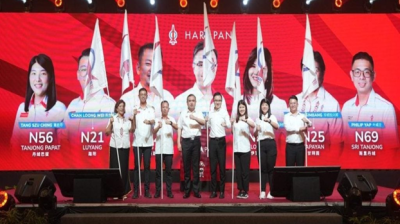
PETALING JAYA: Amid global overcapacity, a “full-blown” price war could be unleashed in the local electric vehicle (EV) space, warns an analyst.
In Malaysia, locally assembled EVs—or also known as completely knocked down (CKD) vehicles—enjoy tax breaks until end-2027. These include exemptions from import, excise, and sales taxes to promote local assembly.
Imported EVs—or completely built-up (CBU) units—have also been tax-free, but only until Dec 31, 2025.
After that, they are set to face full duties again, making them more expensive—although calls to extend the exemptions have grown louder to drive EV adoption.
Additionally, to protect local players, the government had set a minimum price of RM100,000 for imported EVs, also until end-2025.
And with Geely Holding Group chairman Li Shufu warning of “serious overcapacity” in the global automotive industry, Malaysia could feel the ripple effects, especially as EV makers, particularly those in China, offload excess production to new markets.
On these fronts, BIMB Securities analyst Sabariah Akhair said the expiry of the RM100,000 price floor presents a “strategic fork in the road”, with two distinct outcomes depending on future government decisions.
“If policymakers remove the RM100,000 franchise approved permit policy price floor and extend CBU EV tax exemptions beyond 2025, we expect a full-blown EV price war,” she said.
She said this scenario could pave the way for a surge of cheap Chinese EVs like the BYD Seagull and Wuling Mini EV priced as low as RM18,000 to RM45,000.
Sabariah cautioned that traditional players, especially those without local assembly (CKD) scale or cost control, may delay investments or cut output.
“While consumers would benefit in the short term, the local EV industry risks being hollowed out, impacting jobs, localization and long-term industrial growth,” she said.
On the other hand, Sabariah said if the government allows the CBU tax exemptions to expire as scheduled while removing the RM100,000 price floor, the outcome could be more “orderly.”
“We expect a more orderly and sustainable EV market.
“Prices of imported EVs would gradually return to previous levels, avoiding a destructive price war and supporting Malaysia’s localization goals.”
Overall, she believes EV adoption may grow at a steadier pace of between 3.5 percent and 4 percent of total vehicle sales—or total industry volume (TIV)—in 2025, but this approach supports long-term industry development.
“Still, success depends on clear policies, robust charging infrastructure and affordable financing to support broader adoption.”
To note, the Malaysian Automotive Association (MAA) reported that EVs accounted for 2.9 percent of TIV in the first quarter of 2025, up from 1.8 percent in 2024.
An industry observer closely tied to EV distribution said the end of the import duty and excise tax exemptions on imported EVs at year-end will push prices up next year, making new imports less viable and potentially leading to a drop in EV sales volume.
“But with the removal of the RM100,000 floor price, more new models will find their way to Malaysia,” he added.
He believes that internal combustion engine (ICE) vehicles remain relevant, and this is where traditional players will continue to hold ground.
“EV adoption may take time due to limited charging infrastructure and range anxiety among consumers. Range-extended EVs (REVs), which help overcome range anxiety, may be more relevant in the near term.
“However, no tax incentives are currently offered for REVs, even though they are selling very well in China right now,” he said.
“Time will tell whether ICE cars from China will overtake traditional players. In terms of driving performance, they are still lacking.”
Meanwhile, BIMB’s Sabariah said incumbent distributors—or the traditional players—such as Bermaz Auto Bhd and Sime Darby Bhd are “fundamentally equipped to sustain their market presence despite escalating competition from Chinese EV entrants.”
“Both companies have demonstrated strategic foresight by expanding their EV portfolios, thereby aligning with shifting consumer preferences and regulatory tailwinds supporting EV adoption,” she noted.
However, she expects some near-term market share erosion, particularly in the B and C-segment passenger space where Chinese brands are most aggressive.
“While the landscape is undoubtedly becoming more fragmented, we believe both Sime and BAuto have laid solid groundwork for long-term resilience.”
On local marques, Sabariah said both Proton and Perusahaan Otomobil Kedua Sdn Bhd (Perodua) remain structurally well-positioned to defend their market share amid growing competition from Chinese EV brands.
Proton, in particular, she said has made a notable entrance into the EV space with the launch of the e.MAS 7, which has quickly gained traction—topping EV registrations in early 2025.
“Backed by its strategic alliance with Geely and the ongoing development of the Automotive High-Tech Valley (AHTV) in Tanjung Malim, Proton is laying the groundwork for a vertically integrated EV ecosystem,” she noted.
“We see long-term upside in localized production, which could significantly lower production costs and provide pricing flexibility to compete against value-driven CBU imports from China.”
Perodua, on the other hand, is expected to unveil its first EV—targeted below the RM100,000 price point—by end-2025, “directly addressing the mass-market segment.”
“Unlike other rebadged models, Perodua’s EV is reportedly developed from the ground up, reinforcing consumer trust in its engineering and brand identity.
“Moreover, the anticipated adoption of a Battery-as-a-Service (BaaS) model—where batteries are leased rather than owned—may ease affordability concerns and further differentiate Perodua from lower-trust Chinese offerings,” she added.
“In our view, both national carmakers benefit from strong brand equity, entrenched dealership networks, and long-standing government policy support.
“While we acknowledge the near-term pricing pressure from an influx of CBU EVs, the local players’ focus on CKD localization, cost optimization, and mass-market appeal should enable them to weather the storm and maintain relevance in a more competitive landscape.”
Meanwhile, the industry observer noted that tax exemptions for imported EVs will eventually require China EV manufacturers to start their CKD projects.
“From 2026 onwards, Chinese EV makers will need to set up CKD projects in Malaysia to maintain tax incentives. But due to volume constraints, this may not be viable for many of them,” he said.
“I understand that Perodua is developing its EV below RM100,000, so it may not be affected by the influx of Chinese EVs. If Proton can do the same through its partnership with Geely, it will be in a stronger position compared to those Chinese carmakers without CKD operations in Malaysia,” the observer added.
ADVERTISEMENT
ADVERTISEMENT








































